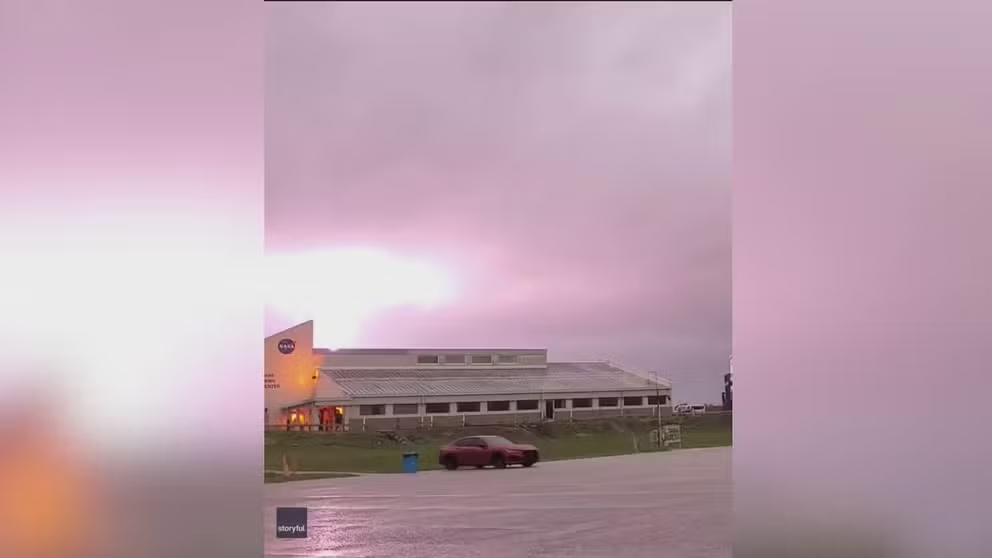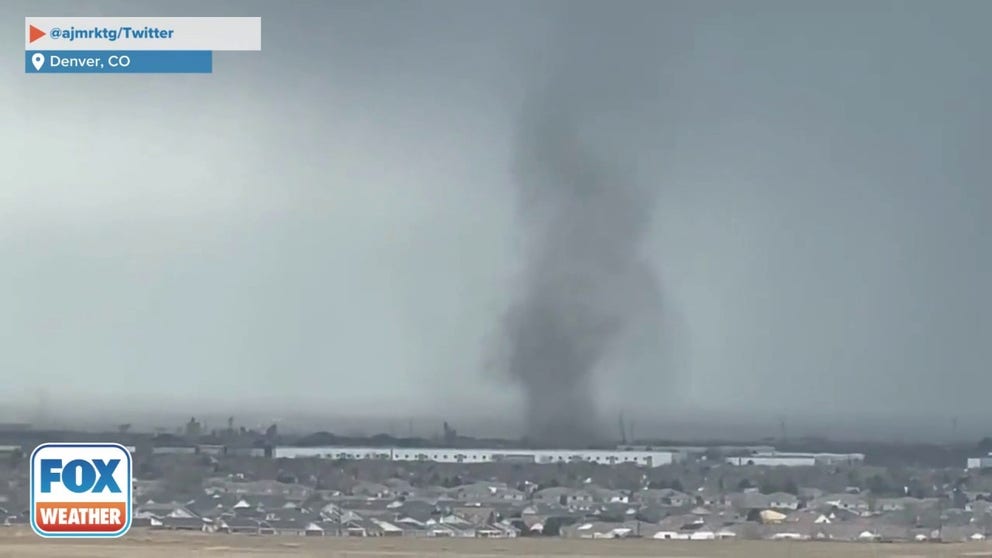Weekend Weather Wows: Portland ties record for temperature laziness while Denver walks on wild side
April 24, 2023 might have gone down as the most boring day ever, weatherwise, for those in Portland, Maine, while those in Denver had one of their more exciting days -- at least those flying into the airport.
Lightning strike seen over NASA building as storms sweep across eastern Florida
Several lightning strikes were seen illuminating a dark cloudy sky behind a building at NASA’s Kennedy Space Center, as severe storms moved across eastern Florida on Thursday, April 27.
PORTLAND, Maine – It's one of those weeks when the weather that shouldn't be newsworthy is making the news.
Welcome to our new weekly feature, "Weekend Weather Wows," where we'll go back and find the most exciting tidbits of weather you might have missed over the past week, so you'll be ready to impress at the water cooler (or virtual water cooler) come Monday.
Well, that was one boring weather day there, Portland
April 24, 2023, might have gone down as the most boring day ever, weatherwise, for those in Portland, Maine.
Amid a day-long drizzle and mist Monday, the high temperature reached a balmy 44 degrees after an overnight low of 43 degrees.
Actually, "overnight" low is misleading because it was 43 degrees for approximately 22 of the 24 hours that day, only briefly clawing its way to 44 degrees in the afternoon. I’m sure everyone instantly noticed and took off a layer.
The paltry 1-degree spread tied an all-time record for temperature laziness in Portland — it was only the third time in their records that a day had a high and low separated by one degree. The other dates: Feb. 8, 1971 (30/29) and March 22, 1945 (32/31), according to the National Weather Service office in aptly-named Gray, Maine.
The weather excitement doubled the next day when the high and low managed a two-degree spread (44/42), setting a daily record for temperature change futility.
In sympathy, it also drizzled a bit in namesake Portland, Oregon, on Monday, but here, the high reached all the way to 59.
By the way, did you know Portland, Maine has its twin-named city in Oregon due to a coin flip? When the Oregon town was established, the settlers used a flip of a penny to decide between naming the town after Portland or Boston. Oregonians came that close to "paahking" their bikes outside the "cawffee" shop.
Carl Sagan would be proud of our math skills
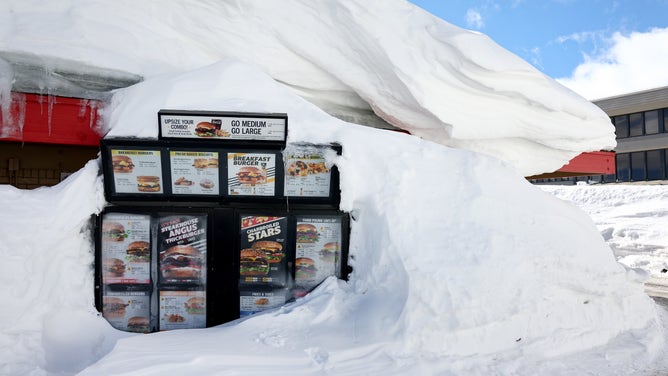
FILE – A Carl's Jr. drive-through menu is partially buried in a snowbank after a series of atmospheric river storms brought heavy snowfall to the region on January 22, 2023, in Mammoth Lakes, California.
(Mario Tama / Getty Images)
You may have heard it snowed quite a bit in the Sierra Nevada this past winter and spring, with dozens of atmospheric river storms leaving "ridiculous" (my word) amounts of snow piled up. But it was a banner year for mountain snowfall across the West.
RIDICULOUS PHOTOS SHOW AFTERMATH OF 12 FEET OF SNOW IN CALIFORNIA'S SIERRA NEVADA
Utah's Alta ski resort piled on to its record-smashing season when the season's snowfall total crossed over 900 inches -- the resort hadn't even hit 800 inches before, much less 900 inches.

(FOX Weather)
We did the math (actually, our FOX Weather's Senior Weather Data Specialist Shane Brown did) and calculated that there were approximately 86.5 trillion gallons of water locked in frozen form across 11 western states as of April 14. That's enough to fill Lake Tahoe twice.

(FOX Weather)
It turns out about 239 billion gallons of that water is held in snowpack around California's Yosemite National Park area. That's enough to fill just under 5 million Beverly Hills swimming pools.
The last thing a pilot wants to see on the weather report
Pilots heading in and out of Denver International Airport had to worry about more than just other air traffic and topography Tuesday. A landspout -- which is somewhat similar to a tornado, just different dynamics in play, was swirling just beyond the air fields.
Landspout caught on video in Denver, CO
Landspout caught on video in Denver, Colorado on Tuesday. A Winter Weather Watch is in place for the area. (Credit: @ajmrktg/Twitter)
It was visible to the airport's weather observers, who noted the tornado in the official weather observation.
THIS IS THE LIFE CYCLE OF A TORNADO

Pilots heading in and out of Denver International Airport had to worry about more than just other air traffic and topography Tuesday.
(FOX Weather)
According to NOAA, it’s the sixth time a tornado has been spotted from DIA since 1996. But at least they're ready for it.

A sign directing people to a Tornado Shelter at Denver International Airport.
(Scott Sistek / FOX Weather)
Florida pads its grip as lightning king of the U.S.
SpaceX was supposed to launch a rocket on Thursday, but took a look at the impending forecast and was like: Nah…
SpaceX forced to delay launch of Falcon Heavy rocket as lightning strikes seen near launch pad
SpaceX was forced to delay the launch of its Falcon Heavy rocket, as severe storms battered the east coast of Florida on Thursday, April 27. Video shows a lightning strike near the launchpad of the heavy-lift rocket.
And that was a good thing. Thunderstorms carrying over 10,000 lightning strikes moved through the Cape Canaveral area Thursday afternoon and evening.
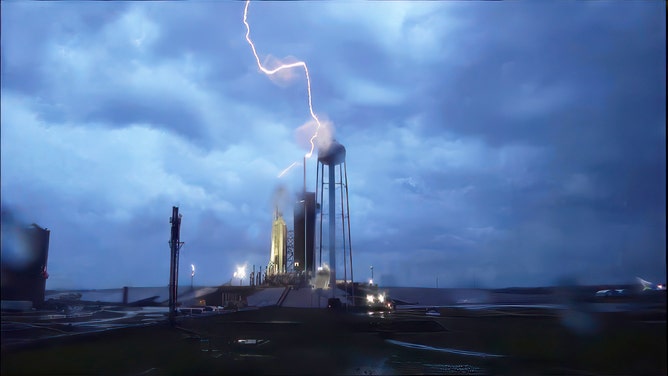
A lightning bolt strikes a the SpaceX launch pad 39A at Cape Canaveral, Florida on April 28, 2023.
(SpaceX)
I don't mean that as a general number like "a gazillion" – lightning detection equipment from Vaisala XWeather actually detected 10,584 lightning events between noon and 8 p.m EDT Thursday just within 12 miles (20km) of Cape Canaveral. Of those, just over 2,000 strikes hit the ground – and at least one hit a launch tower.

Over 10,000 lightning strikes detected by Vaisals within 20 km of Florida's Cape Canaveral between noon and 8 p.m. EDT on April 28, 2023.
(Vaisala XWeather)
Vaisala also found that 101 lightning strikes hit the ground within a 6-mile radius of the launch pad within the hour of the photographed lightning strike.
Hail stones that are lightning fast
Much of the midweek weather drama centered around large hail across Texas, the Gulf Coast and into Florida.
One hailstone in particular caught our attention in Waco, Texas, measuring 4.5 inches in diameter -- about the size of a grapefruit. That is the largest hailstone measured so far this season, but also provides proof that you don't need a tornado or a hurricane to see weather reach speeds of 100 mph.
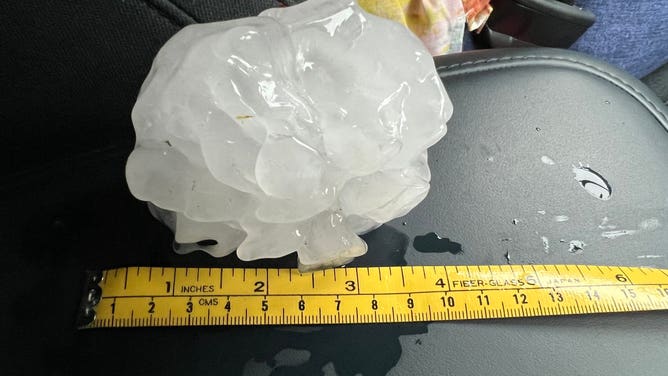
Hail the size of a grapefruit fell new Waco, Texas, on Wednesday, April 26, 2023.
(@Matthews81651563 / Twitter)
According to NOAA, a vertical updraft would need to be around 100 mph to support a hailstone that large and heavy.
Think about those massive fans at the bottom of those big tubes that allow you to simulate skydiving by blowing air fast enough to keep a human airborne.

Look! He's simulating what it's like to be a large hail stone!(?)
(Scott Sistek)
In a thunderstorm, updrafts are what keep hail stones stuck inside clouds where they can attain more moisture and ice to grow.
But once the hail stone is finally heavy enough where gravity defeats the updraft, it can fall just as fast to the ground. NOAA says baseball-sized hail will fall at speeds of 44-72 mph but stones as large as 4 inches across or more can fall at speeds of 100 mph or more.
Who needs the 70s anyway?
My watery eyes and occasional earth-shattering sneeze would tell you it’s allergy season out there, but while it’s not really possible to be allergic to a specific temperature range, Seattle is testing the theory.
The high on Friday in the Emerald City reached 80 degrees — it was not only the first 80 degree day of the year (about three weeks early) but the first day this year to even each at least 70 degrees as well. The National Weather Service in Seattle says as far as they can tell, blowing past the 70s and going straight to 80 as a first 70 and 80 degree day of the year was the first time since 1984.
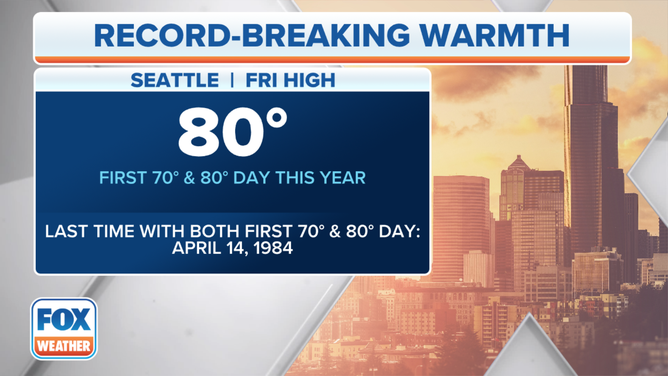
(FOX Weather)
ALLERGY SEASON IS STARTING EARLIER, LASTING LONGER AND GETTING WORSE, STUDY SAYS
But more strange, Seattle did it in reverse in the fall. Oct. 16 reached a record high of 88 degrees. The next day it was in the 60s and Seattle would not reach 70 again until Friday.
Seattle’s forecast high Saturday is 76. Have the Claritin ready …
Other Weather Tidbits of the Week:
- Greenville-Spartanburg area of South Carolina experienced their wettest April day on record with 4.40 inches of rain Thursday. There was about 22 hours of consistent, non-stop rain in the region. The previous April rainfall record was 3.34 inches set in 1963.
- Phoenix was set to reach 100 degrees for the first time this year over the weekend. No big deal though, the average first 100 degree day there is May 2.
- Texas was the grand prize winner of the large hail, but Florida made the podium in second place but it was a rare occurrence! The National Weather Service office in Melbourne, Florida reports only 3% of hail reports reach 2 inches in diameter or larger, but there were widespread reports of 2.50 or larger this week
- Pueblo, Colorado received 2.09 inches of rain across Tuesday and Wednesday — that accounts for just over 17% of their annual average!
